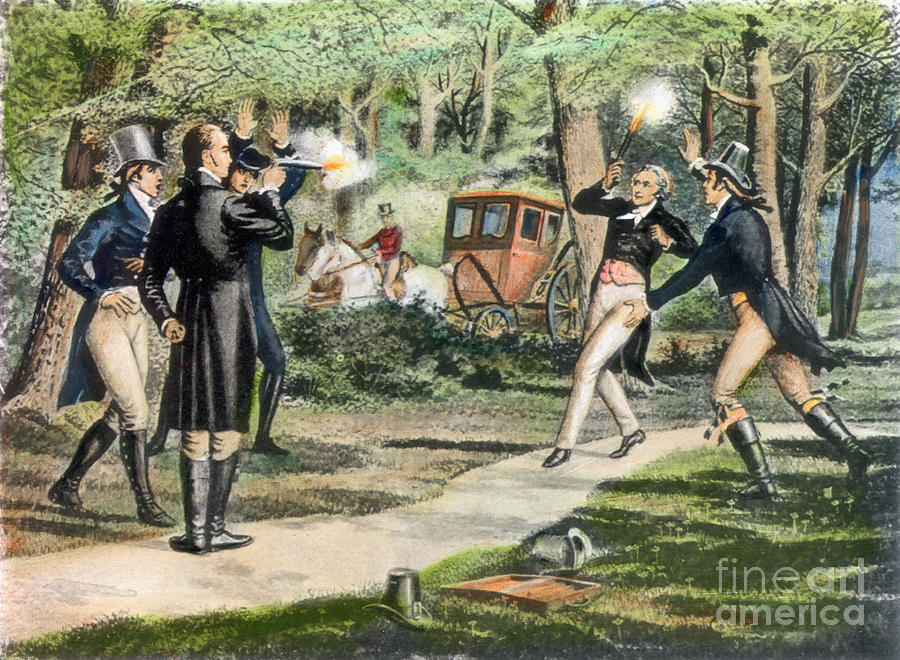In the summer of 1804, a single event rocked the foundations of the United States—Vice President Aaron Burr killed Alexander Hamilton in a duel. The fallout from this fatal encounter would change the course of American politics and public opinion for years to come. Burr’s reputation as a “murderer” became a heavy burden, while Hamilton’s death made him a martyr for the Federalist Party. This dramatic moment in history is both a tale of personal rivalry and a reflection of the political tensions of the time.

The Duel and Its Immediate Aftermath
The fateful duel occurred on July 11, 1804, when Burr, driven by longstanding political and personal conflicts with Hamilton, shot and killed the former Treasury Secretary. The news spread quickly, causing an uproar. Hamilton, a key figure in the foundation of the American financial system, was mourned by many as a martyr for his political ideals. His death left a vacuum in the political landscape, while Burr, who survived the duel, became a pariah.
Following the duel, Burr fled New York, where he was facing charges of murder. His escape took him first to Philadelphia, then to South Carolina, where he sought refuge with his daughter and son-in-law. The southern and western territories were more tolerant of duels, providing Burr with temporary safety.
Burr’s Fall from Grace
Despite finding some relief, Burr’s situation remained dire. He had accumulated significant debt from a lavish lifestyle and was financially strained after Hamilton’s death. Burr’s once-comfortable existence was in ruins, and he faced mounting pressure from creditors who seized his properties and belongings. At one point, he joked to his daughter about which state—New York or New Jersey—would be fortunate enough to execute a former vice president.
Political Return and the Impeachment Trial
Despite his scandalous reputation, Burr returned to Washington D.C. in November 1804 to complete his term as vice president. His arrival shocked many who had assumed he was in hiding. However, President Thomas Jefferson and Secretary of State James Madison welcomed him back, perhaps out of a desire to maintain political stability.
Burr’s legal expertise became an asset during an impeachment trial in the Senate later that year. The trial, which centered on the impeachment of Supreme Court Justice Samuel Chase, required Burr to act as the presiding officer. Burr’s impartial conduct earned him praise, and the Senate ultimately voted to acquit Chase.
Burr’s Final Speech and Political Ambitions
As the 1804 election results came in, Thomas Jefferson and George Clinton were re-elected as president and vice president, respectively. On March 2, 1805, Burr gave his final speech in the Senate, marking the end of his political career. His farewell speech, filled with grace and eloquence, moved many senators to tears.
On March 4, Burr attended Jefferson’s second inauguration as a guest, and soon after, he set his sights on a new ambition—one that would lead him to a dangerous path.
The “Darkest Conspiracy”
Following his departure from Washington, Burr began planning an audacious scheme, which would later become known as the “Burr Conspiracy.” Burr aimed to create a new independent nation in the western territories, potentially ruling as its emperor. To achieve this, he enlisted the help of James Wilkinson, a disgraced military officer with dubious loyalties. The conspiracy involved occupying Spanish territories, including present-day New Mexico and Texas, and perhaps even Mexico City itself.
Though Burr’s true intentions remain unclear, he sought to incite rebellion in the West, with the backing of British forces. His plan involved rallying support from Westerners, including prominent figures like Senator John Smith and future President Andrew Jackson. However, suspicion began to grow as Burr’s efforts to recruit allies in the West raised concerns about his true motivations.
The Conspiracy Unravels
Burr’s plans began to unravel when an anonymous article published in the United States Gazette accused him of attempting to secede from the Union and invade Mexico. President Jefferson received multiple reports of Burr’s actions, but he initially dismissed them. However, as the conspiracy gained momentum, it became impossible to ignore.
In 1806, Burr’s former ally, Wilkinson, betrayed him, sending crucial documents to President Jefferson that exposed Burr’s plans. As a result, Burr was arrested, though his trial was far from straightforward. The case would eventually involve a constitutional confrontation over the writ of habeas corpus, which ensured the right of individuals to seek protection from unlawful detention.
The Legal Battle: A Constitutional Crisis
The legal proceedings surrounding Burr’s conspiracy sparked a major constitutional debate. The case brought to light fundamental questions about executive power, individual rights, and the limits of government authority. At the heart of the issue was the writ of habeas corpus, a fundamental legal safeguard that guarantees a person’s right to be free from unlawful imprisonment.
Burr’s case came to a head in the U.S. Supreme Court, which ultimately ruled on whether the writ of habeas corpus could be suspended during times of national emergency. While Burr was acquitted of treason, his political career was effectively over, and his reputation was irreparably damaged.
Legacy and Cultural Impact
The legacy of Aaron Burr is one of controversy and intrigue. His actions, both during his time in office and after, raised critical questions about the nature of American democracy and the balance of power. Burr’s life serves as a cautionary tale of ambition, betrayal, and the fine line between heroism and treason.
In modern times, Burr’s story has continued to capture the imagination of historians, filmmakers, and playwrights. Most famously, the musical Hamilton brought his complicated relationship with Alexander Hamilton to a new generation of audiences. The events of 1804, including the duel and the subsequent conspiracy, remain an essential part of American history.
While Burr’s life was marked by ambition and scandal, it also reflects the turbulent political environment of early America. The challenges he faced highlight the ongoing struggle for power and influence, a theme that continues to resonate in contemporary political discourse.

No comments yet.